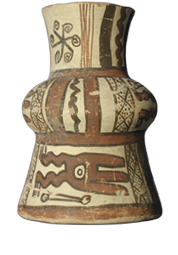The shapes of things that were: applying Huarpa art (ad 250-700) to the Lewis-Williams and Dowson entoptic model for shamanism
Las formas de cosas que fueron: el arte Huarpa (250-700 dc) aplicado al modelo entóptico de Lewis-Williams y Dowson para el chamanismo
Endogenous images are geometric shapes visualized involuntarily due to psychotropic (e.g., intoxicants) or physical (e.g., migraines) stimuli. According to the Lewis-Williams and Dowson neuropsychological model, artifacts with these shapes hypothetically document ecstatic shamanism. This article evaluates Huarpa style black-on-white geometric pottery (Ayacucho valley, Peru) to question how the shapes originated. Ceramic data represents the early, middle, and late phases of the Huarpa culture (ad 250-700). Results indicate that evidence to support ecstatic shamanism is a combination of endogenous shape analysis and the broader cultural context of Huarpa’s social network.
Keywords: endogenous, shamanism, Huarpa, Wari, Anadenanthera colubrina, Trichocereus pachanoi.
INTRODUCTION
In the central Peruvian Andes, the Ayacucho valley is unlike the neighboring, steep-sided valleys (fig. 1). The broad valley floors and areas of sloping hillside mesas provide a more cultivable landscape. This geography formed a magnet landscape that attracted populations for millennia (MacNeish 1971). From generation to generation, the valley’s ethnic cultures maneuvered along paths of increasing social complexity. In the latter half of the Early Intermediate Period (eip) (ad 250-700) the Huarpa culture settled numerous homesteads and hamlets throughout the valley and eventually a ceremonial complex atop Ñawinpukyo hill now located under the southeast suburbs of Ayacucho (Leoni 2004, 2005, 2006). Notably, Huarpa occupation intensified on a defensible mesa just west of modern Quinua. During the Middle Horizon (mh) (ad 700/750-1000) this occupation is known as Huari, an urban community recognized as the capital of the earliest Andean empire-state, Wari (Lumbreras 1974; Isbell & McEwan 1991; Jennings 2010; Isbell et al. 2018). Huari became an enterprising city of warriors, artisans, proselytizing leaders, and itinerate traders who fostered a cosmopolitan hegemony across the Andes.
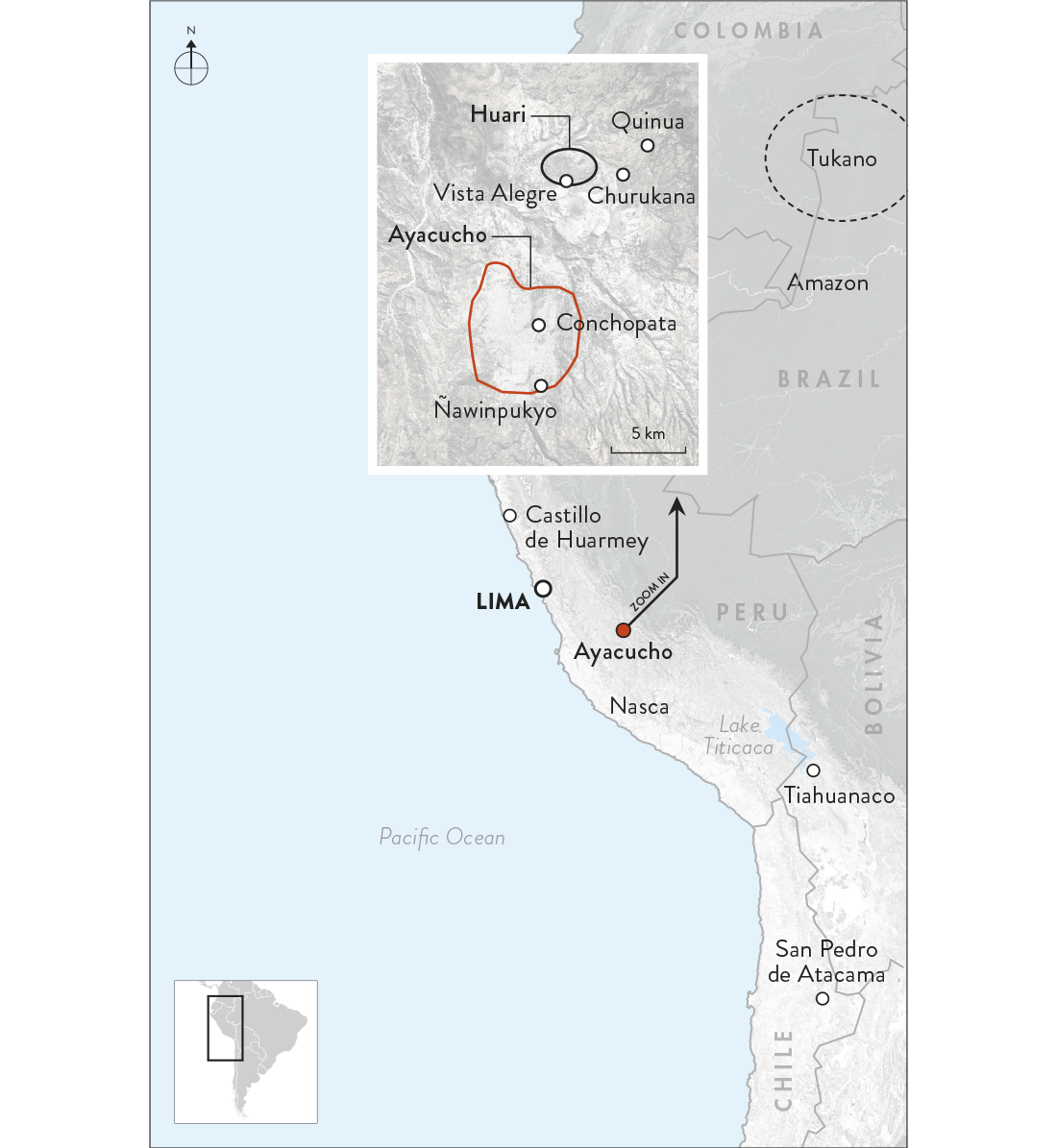
Figure 1. Map shows the modern communities of Ayacucho and Quinua that neighbor the archaeological sites of Huari, Vista Alegre, Churukana, Conchopata, and Ñawinpukyo as well as distant locations mentioned in the text of San Pedro de Atacama, Nasca, Tukano, Lake Titicaca, Tiahuanaco, Amazon, and Castillo de Huarmey. Figura 1. El mapa muestra las comunidades modernas de Ayacucho y Quinua cercanas a los sitios arqueológicos de Huari, Vista Alegre, Churukana, Conchopata y Ñawinpukyo, además de lugares distantes como San Pedro de Atacama, Nasca, Tukano, Titicaca, Tiahuanaco, Amazonas y Castillo de Huarmey mencionados en el texto.
Middle Horizon polities that participated in Wari’s hegemony ‒whether by choice or by force‒ were indoctrinated with iconic themes of therianthropic beings that represent Andean ritual concepts of huacas. How was this belief system actualized? A current scenario relies on an incursion of altiplano depictions of supernatural beings known as the Southern Andean Iconographic Series (hereafter sais) (Isbell & Knobloch 2009) that enhanced Wari’s leadership prowess with symbolic power (Menzel 1964; Knobloch 2000; Haeberli 2018). However plausible, this scenario does not fully address possible pre-mh conditions that may have facilitated the incursion and Wari’s initial strategies for political unity. I explore the possibility that the Huarpa culture developed such conditions with trade networks that included intoxicants. Results would be beneficial in discovering new insights into inchoate state formation.
In the fourth-to-seventh centuries, Huarpa cultural evidence of intoxicants and foreign involvement relies only on occupation sites and pottery due to the durability of non-organic artifacts in the humid highlands. Textiles as another source of stylistic data are unfortunately nonextant. Huarpa pottery style is notable for its black-on-white, geometric designs (Knobloch 2002: 141-142). This data profile led me to David Lewis-Williams and Thomas Dowson’s (1988) neuropsychological model that the human visual system involuntarily creates black, geometric shapes due to intoxication or altered states of consciousness (hereafter asc) that are replicated as designs on cultural artifacts. Known earlier to Lewis-Williams and Dowson as entoptic images, the shapes are now described as endogenous. This term is more inclusive of images from both the eyes’ optical system and the brain’s visual cortex (Dronfield 1996: 374).(1) Their model references a small sample of endogenous shapes and their transformations that correlate with stages of a hallucination’s intensity. In other words, dots, zigzags, or concentric circles alone are synchronically insufficient.
The model has been critically debated in rock art literature for decades, at times contentiously (Lewis-Williams 1999, 2007; Solomon 2006a, 2006b; Pearce 2007). Two reasonable criticisms refer to shaman trances as the assumed source of the shapes (Dronfield 1993: 182) and to ethnographic analogy. Dowson (2007: 58) has tempered the first with acknowledging that the “control of supernatural potency was not the exclusive preserve of shamans”.
The second considers ethnographic analogy a methodological weakness. For example, Australian Aboriginal people depict entoptic shapes that are simplifications of observed phenomena or traditional symbols connected to “the dreaming” of cosmogonic myths or legends without recourse to altered states of consciousness (Tanudirjo 2004). In other words, black geometric shapes could originate from voluntary replications dictated by cultural traditions. The San people –Southern Africa’s 20,000-year-old culture– are Lewis-William’s choice for ethnographic analogy. With David Pearce (Lewis-Williams & Pearce 2012: 75-76), their rejoinder is an explanatory approach that Alison Wylie’s (1989, 2002) astute scrutiny of the literature on the philosophy of archaeology provides:
Deriving this notion from Clifford Geertz, Wylie writes of “tacking” between researchers theoretical, abstract concepts and the concrete practices and “residues” of past peoples […]. In “tacking” between ethnography and images and thereby clarifying the “fit” between the two, researchers need, wherever possible, to balance past and present indigenous concepts against our own interpretative concepts.
“Tacking” can create multiple lines to fitting theory with observable evidence such as stratigraphic principles with settlement patterns, stylistic seriation with art traditions, bioarcheological data with food extraction as well as endogenous images with ecstatic ritual. Wylie (2002: 161-167) characterized such lines as examples of analytical exclusivity or the “disunity” of archaeological evidence; but, if they demonstrate compatible mechanisms of evidential support, then their combination or intertwining can strengthen an argument like an entwined cable. Not an easy task, yet this approach to decades long research has strengthened the Lewis-Williams and Dowson neuropsychological model with comparative rock art paintings to known San behavior, such as in the trance dance (Lewis-Williams & Pearce 2012: 82). They now stand steadfast that their research is not reductionist –“there is always a complex interaction between the neurology of the brain and people’s cultural milieu”– and with recent neuropsychological research, “human consciousness does grade through a series of stages and certain geometric percepts are ‘wired into’ the human brain. These points are now indisputable” (Lewis-Williams & Pearce 2012: 82; emphasis mine).
By resolving these criticisms, I am confident that the Lewis-Williams and Dowson model is applicable to discerning evidence of intoxication from the database of Huarpa pottery. Additionally, rather than use only the model’s six shapes I will review involuntary shapes that originate from non-intoxicants (e.g., migraines) and intoxicants to compile as complete a list of endogenous shapes as possible to identify examples in the Huarpa data. The intoxicants are evaluated to determine accessibility by ancient Huarpa society. Then, I describe the Lewis-Williams and Dowson model and apply the Huarpa data. Discussion introduces a brief background on Andean intoxicants and an evaluation of other lines of evidence that further defines Huarpa prehistory. Conclusions represent my interpretation of the results.
DEFINING ENDOGENOUS SHAPES
Mardi Horowitz’s (1964, 1975) research presented the original hypothesis that a common origin –his “nidus”– in the “anatomic characteristics of the eye or arising in the bioelectrical circuits for pattern receptivity in the retinal ganglionic network” (Horowitz 1964: 520) initiated redundant imagery from different stimuli. He studied subjects on lysergic acid diethylamide (lsd) and schizophrenics. They reported hallucinations of angular points becoming dragons, wavy lines becoming flames or snakes, dots flying around, meanders of bloody rivers, vibrating stars, concentric circles like a pebble dropped in a pond as well as observations of motion, such as drift and rotation. His work established the crucial link between the optical and cortical origins that directly contributed to analyses of endogenous shapes.
I will now describe endogenous shapes from non-intoxicant and intoxicant behavior. In each row of table 1, multiple terms that define similar shapes in the literature are listed together. All terms from the research referenced in the text are included.
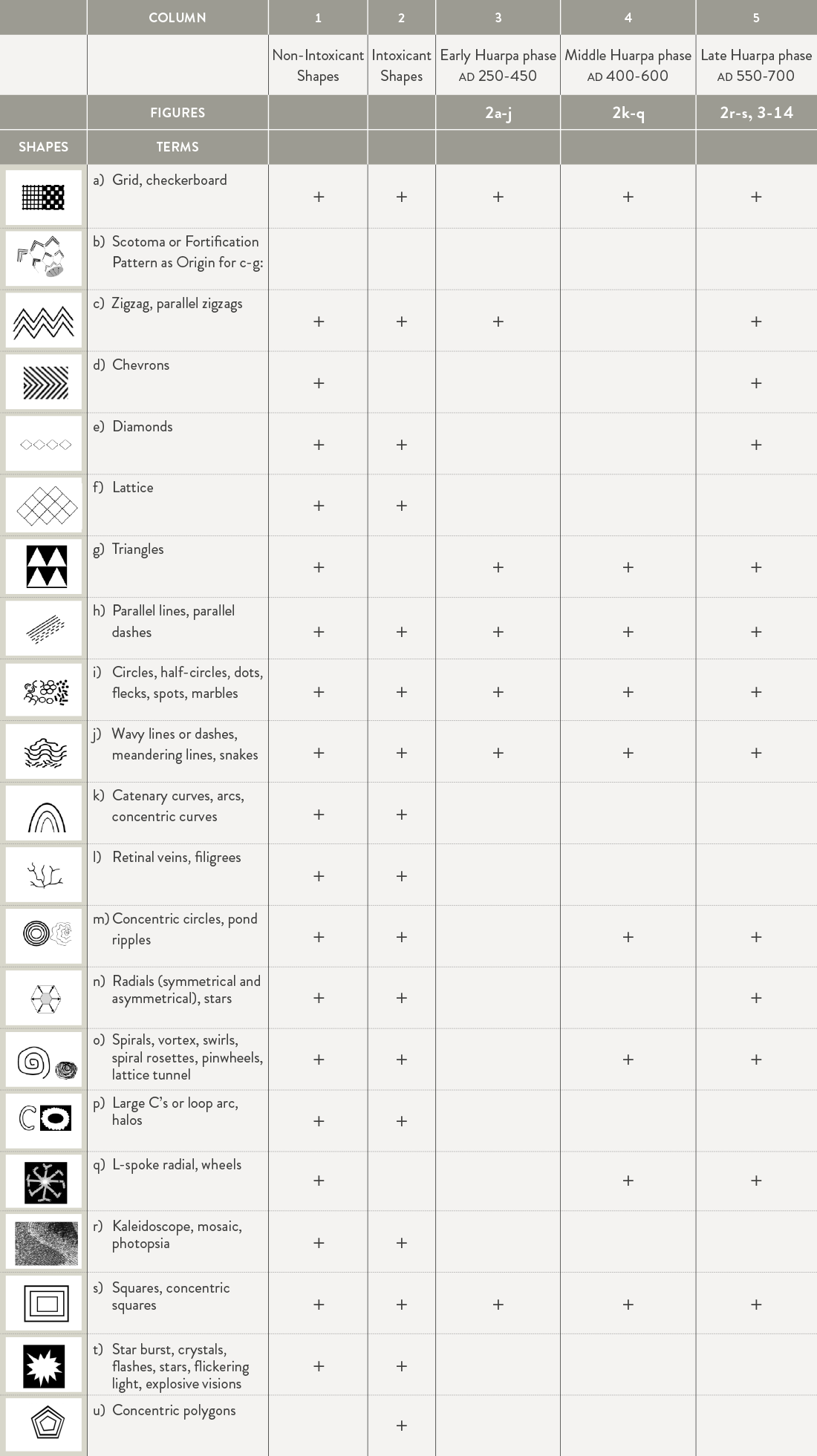
Table 1. Endogenous shapes and pottery samples: + means present. Tabla 1. Las formas endógenas y muestras de cerámicas: + significa presente.
Non-intoxicant shapes
The non-intoxicant shapes result from physical stimuli such as rubbing the eye, staring at a bright light, head injury, migraines and, most commonly, electrical stimuli conducted under laboratory research.
Derek Hodgson (2000: 868) pursued the “underlying neurophysiological causative factor in the perception and depiction of simple lines […]” and endogenous shapes. Since the occipital lobe processes visual data, Hodgson explained how it transforms optical images into geometric shapes that have angles, closures, and T-shaped junctions such as rectangles and zigzags. His explanations for mark-making provide evidence that endogenous shapes can be culturally ubiquitous.
Mark making starts in childhood; so, is child art a source for Huarpa endogenous shapes? Rhoda Kellogg (1967, 1973) compiled a vast database of children’s scribbles. Many resemble endogenous shapes such as circles concentrated into one ring or spread out like loops. However, only one example (Kellogg 1967: Nº 90025) appeared to be a spiral, a common endogenous shape. Others are star shapes or a circle with rays ending in dashes. Children drew circles with rays ending in dashes (Kellogg 1967: Nº 94010-94012), but as legs, feet, arms, or hands to represent people (Kellogg 1967: Nº 94805 and 94887). In another study of child art, Gerald Oster (1970: 87) published a chart from recording 520 electrically induced endogenous shapes that were categorized into 15 groups.(2) Six volunteers were asked to assign 806 doodles from 36 to 43-month-old children into those categories. All volunteers agreed that three categories –parallel wavy lines, concentric or single circles, and dots or specks– each represented 10% of the doodles: otherwise, spirals at 10% by two observers and radials at 10% by one. Grids and parallel straight lines were at least 5% for two observers. This result leaves eight relevant categories with little representation. These studies indicate that Huarpa’s ritual art is far more complex than what children who scribbled in the dirt could have contributed.
Though electrodes did not exist in Andean prehistory, stimulation –both cortical and optical (Wolff et al. 1968)– adds to the inventory of endogenous shapes. Trepanation –removal of skull sections– occurred in the Andes (Verano 2016) and could have led to cortex stimulation mimicking brain surgery patients reporting several endogenous shapes, light flashes and flickering light (Penfield & Rasmussen 1950: 135-147). However, during the eip and mh, cranial holes point to trophy heads for display and not trepanation (Tung 2012).
Max Knoll and colleagues (Höfer 1963; Knoll et al. 1963; Knoll & Welpe 1968: figure 1, as republished in Vitz and Kamorina [2014: 16]) compared 15 endogenous shapes common to subjects in one study of cortical stimulation and three of optical stimulation (Blum 1956; Smythies 1959, 1960; Welpe 1967). With both stimuli, shapes often rotated at different speeds and reversed direction. Most shapes were doublets due to the binocularity of the eyes. Similar results came from 80 lab staff from experiences such as waking, being hit on the head, eye pressure, illness, sleeplessness. The images also rotated and replicated as well as overlapped, combined, or multiplied (Horowitz 1964: 517-518, fig. 5; 1975: 179, fig. 2). Dual replication is a core belief in Andean cultures with many examples of duplicate artifacts (Anders 1986; Moore 1995). A late Huarpa Tricolor collection described below has almost two dozen whole vessels of which five are duplicates (Ravines 2011: 491-492, top figure p. 492).
Migraines create endogenous shapes and studies are extensive (Bernstein & McArdle 2008). During migraines, a dark elliptical shape or scotoma enlarges to obscure one’s vision (Richards 1971; Hachinski et al. 1973: fig. 6; Siegel 1977: 138). The edge of the ellipse has clusters of parallel zigzags and fine hatch lines, often colorful, known as the fortification pattern (Bernstein & McArdle 2008: 64). This pattern can fragment into fine line designs as single and parallel zigzags, chevrons, diamonds, lattices, triangles, and concentric curves. Ronald Siegel (1977: 138) described migraine images as incandescent, shimmering, moving, rotating, and enlarging. It is reasonable to consider that Huarpa migraines existed since the first recorded incident was in 1200 bc by the Egyptians.
Endogenous shapes can also be observed by applying pressure at the corners of the eyes (Oster 1970; Tyler 1978; Walker 1981), staring at flickering light (Smythies 1960; Young et al. 1975; Walker 1981), and cross-eyed staring at close objects (Tyler 1978: 1635, figs. 1A, B and C). Jearl Walker (1981) and Gerald Oster (1970) reproduced such imagery. Walker (1981: 178) describes the prisoner’s cinema where total darkness produces interfering waves and vague splotches of light. He replicated the checkerboard shape –common in the Huarpa style– by facing a bright bulb and slowly fanning his spread out fingers up and down in front of closed eyes; with one eye covered, wavy and curved lines formed whereas with both eyes triangles and squares appeared (Walker 1981: 180). Maclay and Guttman (1941: 132) state that eye pressure produces photopsia –mosaics of flowing-colored pixels– as in their mescaline study. Points of high luminance in darkness created the L- or T-spoked radial, another common Huarpa shape (Tyler 1978; Navarro & Losada 1997: 355, fig. 2, upper right). Perhaps staring into a fire or the sun sufficed to create some Huarpa designs.
Intoxicant shapes
Only South American intoxicants are included in this study (Schultes 1972; La Barre 1975; Schultes et al. 1998). From her extensive research of plants containing alkaloids to produce psychotropic behavior, Emma Brown (2012) established four categories: tropane alkaloids (cocaine,(3) benzoylecgonine, atropine, scopolamine), phenethylamines (mescaline), β-carbolines (harmine, harmaline), and tryptamines (N, N-dimethyltryptamine, bufotenine).
Atropine and scopolamine are found in Brugmansia (B. suaveolens and B. sanguinea) and Datura (D. stramonium L. ssp. ferox [l.]). The latter is an additive to san Pedro drinks (Rätsch 2005: 210). Though poisonous, skilled shamans can prepare precise dosages for vision quests (Rätsch 2005: 106-108). Unfortunately, Brugmansia cannot be included because all studies that this author could locate only describe the final stage of hallucinations. In the northwestern United States, the Chumash used datura, though only their rock art is extant for study (Dronfield 1996).
In citing Douglas Sharon (1972), Ronald Siegel and Murray Jarvik (1975) note that san Pedro cactus (Trichocereus pachanoi or Echinopsis pachanoi) contains mescaline as found in peyote cactus (Lophophora williamsii), so mescaline studies are included.(4)
Harmine and harmaline occur in Banisteriopsis caapi, which has questionable hallucinogenic effects (Rätsch 2005: 841). Known as an additive in ayahuasca, Brown (2012: 111) points out that there are several authors who now argue that ayahuasca intoxication as a cultural practice in shaman healing rituals began no earlier than the 14th century. Peter Gow (1994: 90-91) and Bernd Brabec de Mori (2011: 36-37) document that such practices developed only in Amazon communities associated with the colonial rubber trade whereas unaffected communities do not practice ayahuasca shamanism or –as with the Shipibo– their healing songs used in ayahuasca rituals are in the Inca Quechua language; thus, centuries after the Huarpa culture. With this caveat, B. caapi is not included.
Tryptamine (n, n-dmt) is found in Anadenanthera colubrina and A. peregrina seeds that are processed for snuffing, smoking with tobacco (Nicotiana rustica L. var. humilis Schrank) (Rätsch 1998: 376), ingesting as an enema (Torres & Repke 2006), and drinking in chicha (a corn-based beer) (Quispe 1969: 35-38; Isbell 1978: 151-158). Known as Inca villca (cebil) (Yacovleff & Herrera 1935), the profound hallucinations are “often black and white, less frequently in color. These are not, or are only rarely, geometrical but are, rather, very flowing and decentralized” (Rätsch 2005: 52). Thus, Anadenanthera is not a good source for early Huarpa’s geometric art. Though the effects only last 10 to 20 minutes “those few minutes may seem to have spanned centuries. People who have had experiences with dmt unanimously agree that it is easily the most powerful psychedelic known” (Rätsch 2005: 852).
Mescaline will be the primary intoxicant for referencing endogenous shapes. The work of Heinrich Klüver (1926, 1942, 1966) initiated the research of drug-induced visual effects and focused on mescaline. Klüver’s (1942: 177) subjects described shapes or “form-constants” during the first stages of intoxication as geometric shapes that “are frequently repeated, combined, or elaborated into ornamental designs and mosaics” as well as elements such as squares that edge other forms (Klüver 1966: 22). His subjects were most affected by “the kaleidoscopic play of forms and patterns” (Klüver 1966: 177). Since he did not provide drawings, Horowitz (1975: 178, fig. 2) provided translations to his drawings.
Walter Maclay and Eric Guttman’s (1941) subjects were artists who drew their visionary shapes. Parallel zigzags were similar to the migraine fortification pattern, but without the scotoma and “the flickering is firmer and the angles are less clear” (Maclay & Guttman 1941: 133). Instances of repetition or replication produced concentric squares and polygons.
Ronald Siegel (1977) and Murray Jarvik (Siegel & Jarvik 1975) provide a history of intoxicant endogenous images. As cited by Siegel and Jarvik (1975: 108-111), mescaline produced “colored arabesques” and “crystals” (Lewin 1924, 1931; Beringer 1927), “pulsation” (La Barre 1969, in Siegel & Jarvik 1975) and patterns projected upon the real world (Szuman 1930). Douglas Sharon (1972: 133) described san Pedro visions as “a whirlpool of red and yellow light spinning inward” and Schultes (1972: 4) with “brilliantly colored visions in kaleidoscopic movement”.
Siegel and Jarvik (1975) tested subjects under the influence of tetrahydrocannabinol (thc in marijuana), psilocybin (mushrooms), lsd, and mescaline. For mescaline, eleven Mexican Huichol men recalled kaleidoscopic effects and geometric patterns. The lattice-tunnel predominated and “the major colors are blue and red, and the primary movement is explosive motion toward the subject” (Siegel & Jarvik 1975: 138-139).
Though Lewis-Williams and Dowson’s conclusions were considered substantially correct for shamanism in the Upper Paleolithic, Jeremy Dronfield (1993, 1996) was critical of their methodology. He proposed a matrix model to address what possible endogenous shapes can originate in cultures that do (N=4) and do not (N=5) practice intoxication. The matrix (Dronfield 1996: 388, fig. 15) compares the cultures with seven endogenous shapes, eight shapes artistically similar to endogenous images, and two non-endogenous geometric shapes (e.g., square/rectangle and triangle). The results were that intoxicant cultures produce both actual and artistically similar endogenous shapes, but not the two geometric shapes. Non-intoxicant cultures produce artistically similar and geometric shapes that simply reflect artistic creativity. His results are questionably useful.(5) What is significant for this study is that Dronfield’s (1996) endogenous shapes include those from intoxicant cultures that used mescaline and scopolamine so that they can be added.(6)
THE LEWIS-WILLIAMS AND DOWSON MODEL
Within Stone Age research, parietal designs have long been regarded as representations of endogenous origins (Pokorný 1969, in Siegel 1977: 137) such as shamanistic agency (Blackburn 1977; Bednarik 1984). In Europe’s Upper Paleolithic populations between 35,000 and 10,000 years ago, Lewis-Williams and Dowson’s (1988) research assumes intoxicant agency in which involuntary appearances of entoptic shapes were considered supernatural experiences, held sacred, and replicated. The model employs six of the most redundant shapes from both intoxicant and non-intoxicant stimuli (Lewis-Williams & Dowson 1988: 202, fig. 1; 1993: fig. 1, bottom, left) as referenced in Horowitz (1964, 1975), Richards (1971), and Siegel (1977). These choices represent the model’s Component 1.
From pseudo-hallucinatory experiences (Siegel 1977: 136) and neuropsychological research, Component 2 details seven principles of shape transformation: 1) replication, an apparent artistic rendering of an observable endogenous shape such as nested zigzag shape that was most likely experienced from a migraine fortification pattern or L-spoke radials from staring at a point of high luminance; 2) fragmentation, as part of a grid becoming a ladder; 3) integration, as a circle and dot becoming an eye; 4) superpositioning one shape atop another; 5) juxtaposing one shape next to another; 6) reduplication, as in one curve becoming concentric curves; and 7) rotation, as a spiral suggests motion (Lewis-Williams & Dowson 1988: 203).
Component 3 follows three stages during asc’s visual experiences (Lewis-Williams & Dowson 1993: 56). The stages may not be sequential or inclusive. asc cannot be determined if only shapes are studied; Stage 1 are replicated shapes without interpretations since they pass quickly through the vision; Stage 2 involves interpretation such as a wavy line becoming a snake; Stage 3 is the experience of uncontrolled motion as in spirals and animation that can be reported live today but defied ancient skills and became static designs (Lewis-Williams & Dowson 1988: 203-204).
APPLYING CERAMIC DATA
Two other pottery styles, White Cruz Pata and Brown Cruz Pata, are contemporary with the middle and late Huarpa samples as found in excavations at Huari and Ñawinpukyo and are therefore included. White Cruz Pata pottery features black outlining of red, reddish-orange, and bluish-grey bands stylistically like south-coast Nasca art. Brown Cruz Pata pottery features white and black outlining of red or contrasting-colored designs on a brown or brownish-orange background stylistically like Amazonian art.
In this study, Huarpa endogenous shapes pertain to a diachronic line of analysis with three temporal samples to determine if design stylization may have chronicled shamanistic evolvement. All radiocarbon are calibrated with Calib 8.20 shcal20 (Stuiver et al. 1986-2020; Hogg et al. 2020), but with a simplified cal ad equal to or greater than 85% of 1 sigma. Overlapping phases mirror stylization as a learning process. Component 1 (identification) and Stage 1 (replication) occur in all three samples.
Early Huarpa (ad 250-450) sample of nearly 350 diagnostic sherds from Huari is associated with one radiocarbon sample (1713 +/- 120 bp, cal ad 248-502, median = 371) (Knobloch 1976). Fragmentation and juxtaposing occur with single wavy lines next to parallel lines (fig. 2a), circled-dot (fig. 2b), and zigzag with parallel lines (fig. 2c). Juxtaposition and reduplication occur with black dots inside concentric squares (fig. 2d). With the principle of integration, Stage 2 has two effigy vessels (figs. 2e and f) that have black-on-white squares and parallel lines construed into eyes with tearlines on modeled faces as well as a second form with a circled-dot for the head and straight lines for body and limbs (fig. 2g). Stage 1 also includes checkerboard (fig. 2f), grid (fig. 2h), and parallel wavy lines (fig. 2i) and alternating purplish-red triangles outlined in black (fig. 2j).
Middle Huarpa (ad 400-600) sample comes from excavations at Huari (Knobloch 1983) and Ñawinpukyo (Leoni 2004), considered contemporary due to similar vessels and designs. Ñawinpukyo provides two radiocarbon dates from charred beans in a semi-circular structure, ea-14 (Beta-180665, 1600+/-70 bp, cal ad 423-550, median = 499), and charcoal in a circular temple structure, ea-12/19 (aa-46633, 1583+/-34 bp, cal ad 474-579, median = 523) (Leoni 2004: 125-126, 2006: table 11.1). Replication occurs with an L-spoke radial as juxtaposition occurs with straight lines and small dots (fig. 2k), with wavy and straight lines (fig. 2l), and a grid next to concentric circles (fig. 2m). Reduplication occurs with concentric squares (fig. 2n) and rotation with a rosette of black spirals on an unpigmented surface (fig. 2o).(7) Stage 2 continues the principle of integration with modeled human faces and square eyes with tearlines (Leoni 2004: figs. 10.33J, 10.43E and 10.46E). Stage 3 can only be assumed with spiral shapes (fig. 2o). Stage 1 endogenous shapes include checkerboard (fig. 2r). A few White and Brown Cruz Pata style sherds occur in this sample but too small to analyze accurately.
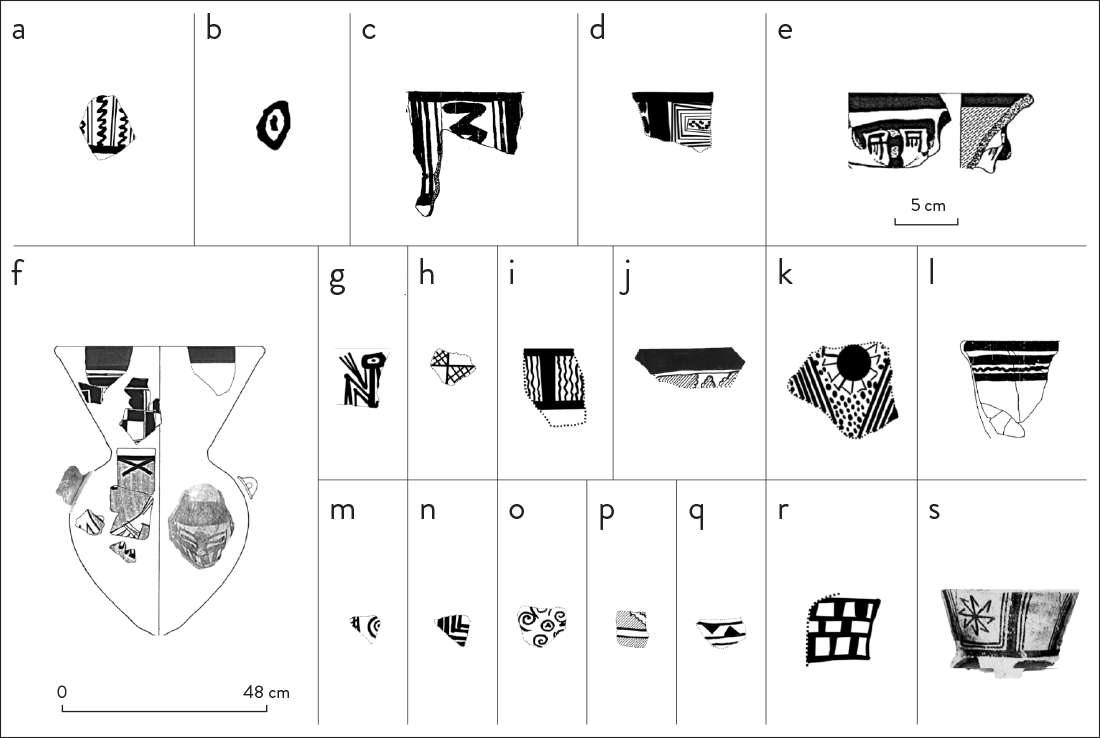
Figure 2. Endogenous shapes painted on Huarpa style pottery; mostly as geometric, black-on-white designs and a purplish-red pigment indicated with diagonal lines added to triangular shapes. The three phases fulfill some of the Lewis-Williams and Dowson model such as Stages 1 and 2 as well as six of the seven principles: replication, fragmentation, integration, juxtaposition, reduplication, and rotation. The figures are assigned to the following phases: a-j) Early Huarpa phase; k-q) Middle Huarpa phase; r-s) Late Huarpa phase. All drawn to scale except “f”. Diagonal lines indicate purplish-red color (drawings by the author. Figure “s” photo by William H. Isbell, from Cabrera [1998]). Figura 2. Formas endógenas pintadas en cerámica de estilo Huarpa, principalmente como diseños geométricos, negro sobre blanco y con un pigmento morado-rojo indicado con líneas diagonales añadidas a formas triangulares. Las tres fases cumplen algunas de las etapas del modelo de Lewis-Williams y Dowson, como las Etapas 1 y 2 así como seis de los siete principios: replicación, fragmentación, integración, yuxtaposición, reduplicación y rotación. Las figuras se asignan a las siguientes fases: a-j) fase Huarpa Temprana; k-q) fase Huarpa Intermedia; r-s) fase Huarpa Tardía. Todos los dibujos fueron hechos a escala, excepto “f”. Las líneas diagonales indican el color morado-rojo (dibujos de la autora. Fotografía de la figura “s” de William H. Isbell a partir de Cabrera [1998]).
Late Huarpa (ad 550-700) sample comes from two caches of sherds excavated at Ñawinpukyo (Cabrera 1998; Leoni 2004). The pottery shows advancement with use of red pigments to produce Huarpa Black&Red-on-White and Huarpa Tricolor styles. Stage 1 shapes include checkerboard (fig. 2r), L-spoked radials (fig. 2s), radials with spiral rays (fig. 3) as well as circled-dots, alternating triangles, angular spirals, and L-spoked radial with extra spokes to enhance the principle of rotation (fig. 4a). Juxtaposition occurs with triangles that form diamonds (fig. 4b). Juxtaposition occurs on a White Cruz Pata style, tall-necked jar with parallel zigzags,(8) parallel wavy lines, symmetrical recurved ray rosette, and a square and diamond shapes with filler circles (fig. 5). The checkerboard pattern is fragmented into large black and white rectangles (fig. 4a and b). Juxtaposition and rotation occur on a Huarpa Tricolor jar fragment with spirals, wavy lines, concentric circles, and chevrons (fig. 6). On a Huarpa Black&Red-on-White fragment another spiral is reduplicated into small red-and-black spirals attached to vertical lines (fig. 7) (also Knobloch 2012: 125, fig. 93). Stage 2 is represented as a creature with the principle of integration of a modeled head above the shapes of a square and a diamond for its body (fig. 5).

Figure 3. Huarpa Tricolor vessel fragments depict radials with spiral rays that are Stage 1 endogenous shapes depicting the principle of rotation. Location: Ñawinpukyo (photo by Juan Leoni). Figura 3. Fragmentos de una vasija Huarpa Tricolor que representa radiales con rayos espirales que son formas endógenas de la Etapa 1 representando el principio de rotación. Lugar: Ñawinpukyo (fotografía de Juan Leoni).

Figure 4. Huarpa Tricolor tall-necked jar fragments: a) a band combining examples of circled-dots, alternating triangles, angular spirals, and L-spoked radials that are Stage 1 endogenous shapes that represent principles of juxtaposition, rotation, and replication; b) a band of triangle shapes and diamond shapes formed from combining triangles that are Stage 1 endogenous shapes and represent the principles of juxtaposition and reduplication; a) and b) the black-on-white rectangles were formed from the fragmentation of the earlier checkerboard patterns (see fig. 2f). Location: Ñawinpukyo (photo by Juan Leoni). Figura 4. Fragmentos de un cántaro de cuello largo Huarpa Tricolor: a) una franja combinando puntos dentro de círculos, triángulos alternados, espirales angulares, y radiales con forma de “L”, que son formas endógenas de la Etapa 1 que representan los principios de yuxtaposición, rotación, y replicación; b) una banda de formas triangulares y formas de diamante producidas al combinar los triángulos, que son formas endógenas de la Etapa 1 y representan los principios de yuxtaposición y reduplicación; a) y b) los rectángulos negro sobre blanco se formaron por la fragmentación de los patrones de tablero más tempranos (ver fig. 2f). Lugar: Ñawinpukyo (fotografía de Juan Leoni).
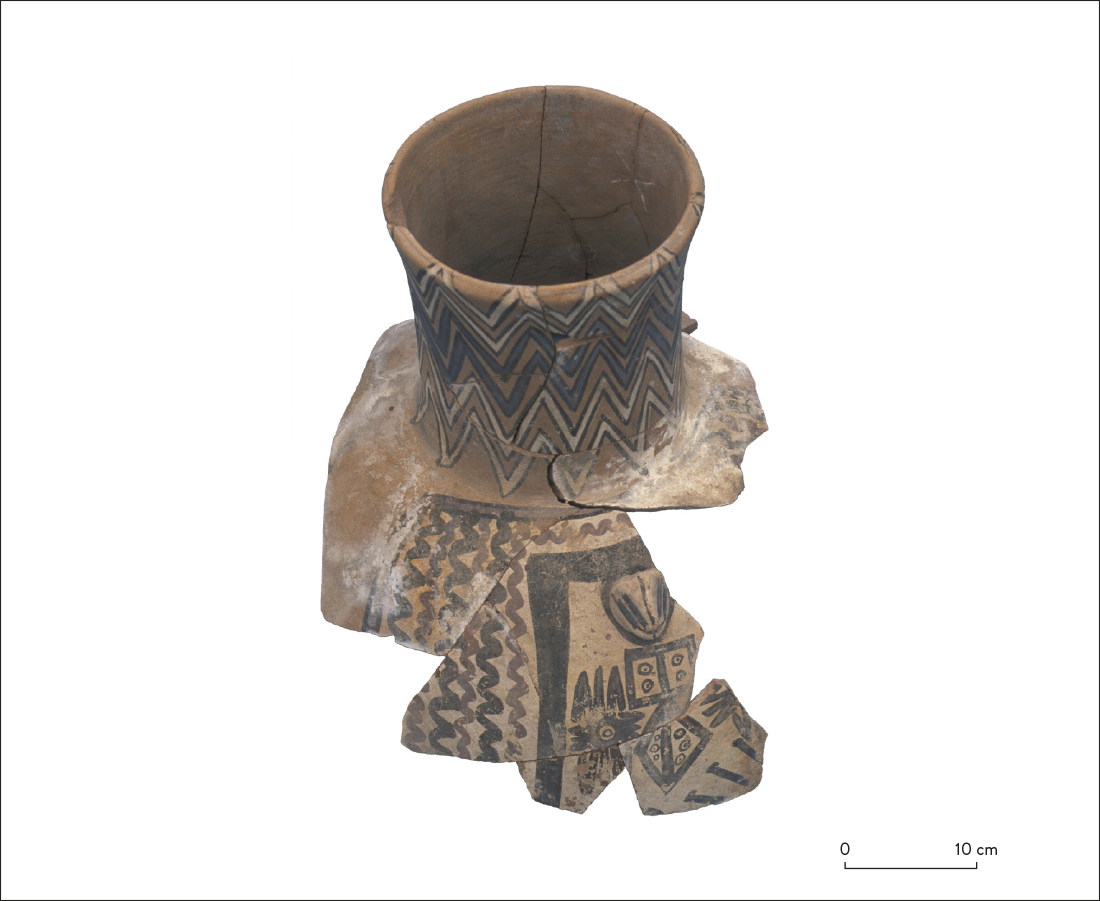
Figure 5. White Cruz Pata tall-necked jar fragment depicts parallel zigzags, parallel wavy lines, symmetrical recurved ray rosettes, and a square and diamond with filler circles that are Stage 1 endogenous shapes that represent the principle of juxtaposition. The last two shapes and a modeled head form a Stage 2 interpretation of a possible creature with the principle of integration. Location: Ñawinpukyo (photo by Juan Leoni). Figura 5. Fragmento de cántaro de cuello largo Cruz Pata Blanco que representa zigzags paralelos, líneas onduladas paralelas, rosetas con rayos recurvados simétricos, y un cuadrado y rombo con círculos de relleno que son formas endógenas de la Etapa 1 que representan el principio de yuxtaposición. Estas últimas dos formas y una cabeza modelada conforman una interpretación de Etapa 2 de una posible criatura con el principio de integración. Lugar: Ñawinpukyo (fotografía de Juan Leoni).
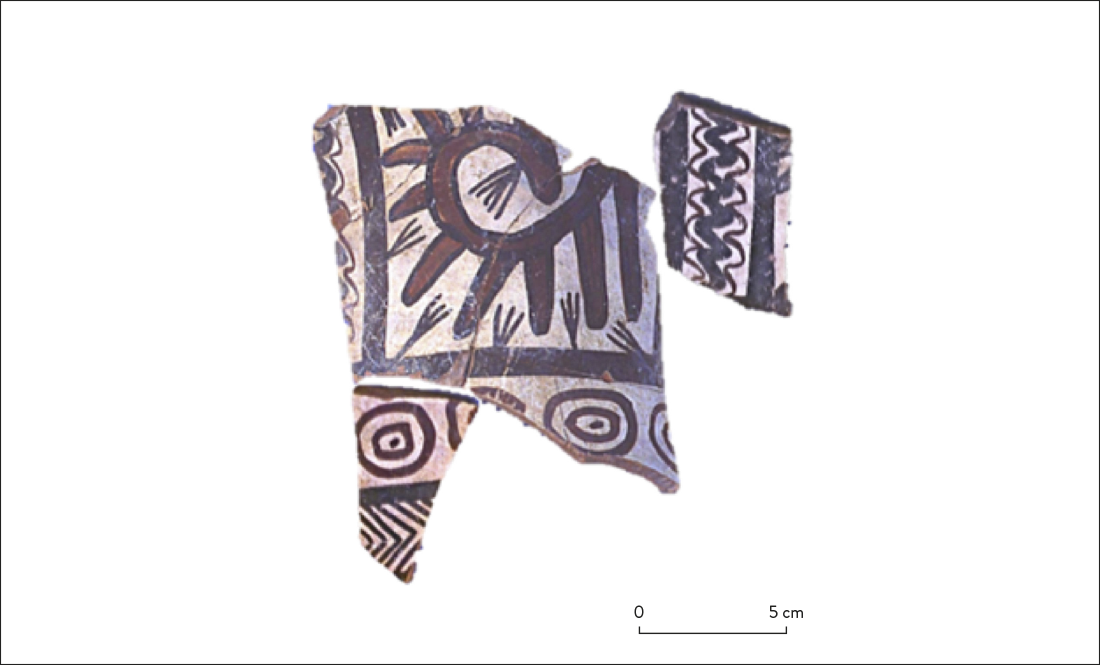
Figure 6. Huarpa Tricolor jar fragments depict spirals, wavy lines, concentric circles, and chevrons as Stage 1 endogenous shapes with the principles of juxtaposition and rotation. The addition of whisker lines and finer, red wavy lines may have created the effect of vibration that could animate the asc experience of rotation and vortex visualization. Location: Ñawinpukyo (Cabrera 1998) (photo by William H. Isbell). Figura 6. Fragmentos de un cántaro Huarpa Tricolor que representan espirales, líneas onduladas, círculos concéntricos, y cheurones como formas endógenas de Etapa 1 con los principios de yuxtaposición y rotación. La incorporación de líneas de bigote y líneas onduladas rojas más finas quizás hayan creado el efecto de vibración que podría animar la experiencia eac de rotación y visualización de vórtice. Lugar: Ñawinpukyo (Cabrera 1998) (fotografía de William H. Isbell).
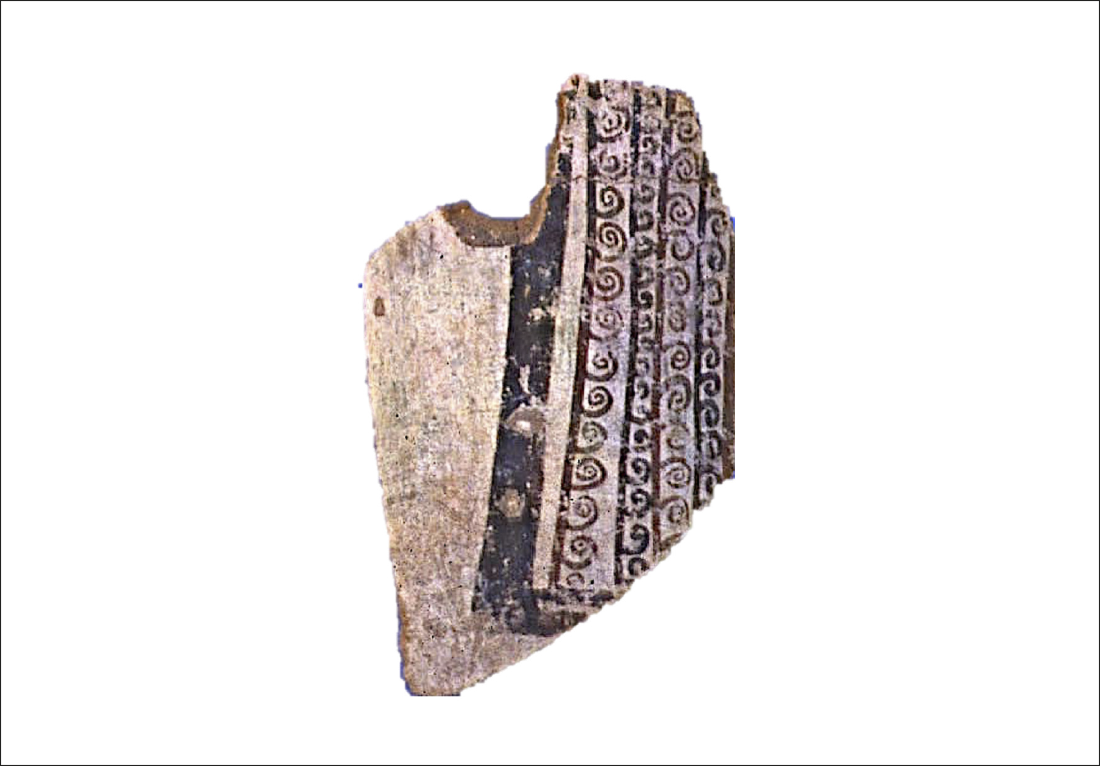
Figure 7. Huarpa Black&Red-on-White vessel fragment depicts parallel lines of small, delicately detailed spirals as Stage 1 endogenous shapes with the principle of reduplication. Location: Ñawinpukyo (Cabrera 1998) (photo by William H. Isbell). Figura 7. Fragmento de una vasija Huarpa Negro-y-Rojo-sobre-Blanco que representa líneas paralelas de espirales pequeños detallados delicadamente como formas endógenas de la Etapa 1 con el principio de reduplicación. Lugar: Ñawinpukyo (Cabrera 1998) (fotografía de William H. Isbell).
The results of this exercise are summarized in table 1. Huarpa’s three phases of endogenous shapes fulfill some of the model’s principles and stages. However, of the 20 possible shapes, 16 originate from both non-intoxicant and intoxicant stimuli (table 1: columns 1 and 2). Seven of those 16 and one from an intoxicant do not occur with Huarpa pottery. Additionally, three out of 13 Huarpa shapes ‒chevrons, triangles, L-spoke radials‒ support non-intoxicant origins (migraines and bright lights). Despite successfully fulfilling many requirements of the Lewis-Williams and Dowson model, all Huarpa endogenous shapes could have come from non-intoxicant origins. Therefore, I cannot claim that Huarpa art originated from ecstatic shamanism beyond reasonable doubt. As Lewis-Williams and Dowson (1993: 56) defined Stage 3 to be “more culturally controlled”, one might expect that centuries of tradition indoctrinated Huarpa potters to be biased toward interpreting artistic expression with the geometry of their artistic language. Also, though the Huarpa data lacks textiles and burials of women with tools, the absence of figurative images may have been tied to a geometry of weaving as Denise Arnold and Elvira Espejo (2013, 2015) have so thoroughly investigated to promote the critical role of women weavers to create Andean technological knowledge.
At this point the results appear inconclusive for establishing Huarpa shamanism. However, a closer stylization analysis of Huarpa Tricolor and Brown Cruz Pata styles intertwines other lines of evidence into a Wylie-like cable strengthening the hypothesis for shamanistic intoxication.
The Huarpa Tricolor, tall-necked jar has a large spiral with fanned out spokes and whisker lines. It is juxtaposed with a vertical wavy band flanked with finer wavy lines. The whisker lines and fine wavy lines animate the shapes as rotating and vibrating, possibly rendering the oft-mentioned vortex experience of an asc (fig. 6).(9) A second jar has an L-spoke radial with interior spokes that animate the shape like a whirligig (fig. 4a). As originating from bright focused light like the sun, this shape’s ubiquity is not surprising. Examples include another Huarpa Tricolor collection of nearly two dozen whole vessels.(10) Another more complex L-spoked radial occurs on a wide-mouthed jar (fig. 8) (Pérez 2016: 179). A simpler version with dash marks occurs on face-neck jars (one of three is illustrated, fig. 9). With reference to the principle of integration, Stage 2 examples of possible creature interpretations occur on a cup, a jar, and a spouted bottle (figs. 10, 11 and 12). The first two creatures have two wavy bands for legs that flow from head shapes and end in comb-like elements for feet. The cup’s creature has a diamond shape for the head that encloses a circle filled with dot and with spiral rays attached for hair. The jar’s creature has a circled-dot head with three spokes for hair. The bottle’s creature occurs on the neck and appears to be double-headed with circled-dots for heads and lines for hair. The spirals may represent arms connected to a line for the body.
This vessel’s body is decorated with spirals attached to vertical bands, spiral rays, and wavy bands ending in dashes. Circled-dots may represent eyes and may decipher the same shape for early Huarpa’s stick figure (fig. 2g). The spiral rays, floating filler elements, and wavy bands animate the imagery and are the clearest evidence that late Huarpa potters came to manipulate endogenous shapes into meaningful beings, however fantastical. Even though san Pedro cactus (a source for mescaline) grows in the area, reasonable doubt may remain for early Huarpa society, but Stage 2 evidence weakens the doubt for late Huarpa society. Next, Brown Cruz Pata style indicates another line of intoxicant evidence.
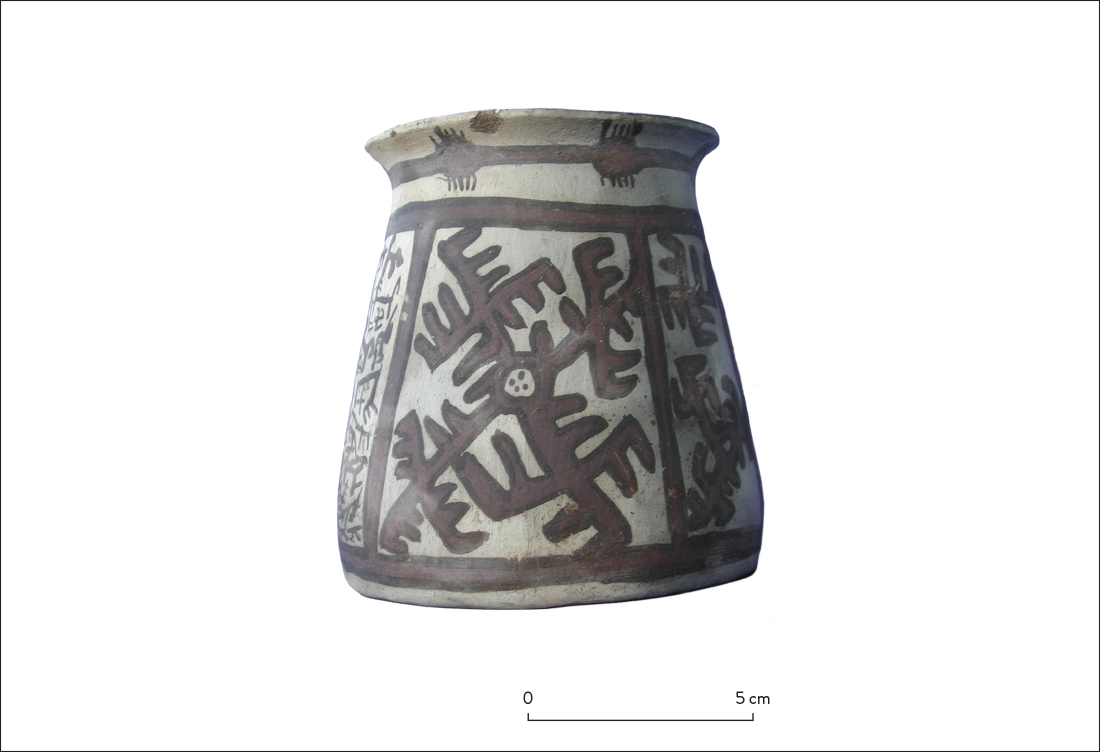
Figure 8. Huarpa Tricolor wide-mouthed jar with a complex L-spoked radial. The stylization of this Stage 1 endogenous shape is a derivative of late Huarpa endogenous L-spoked radial shapes (see fig. 2s). Location: unknown. Fredy Lagos collection (photo by William H. Isbell). Figura 8. Cántaro Huarpa Tricolor de boca grande con un radial con forma de L complejo. La estilización de esta forma endógena de Etapa 1 es un derivado de los radiales con forma “L” endógenos huarpa tardíos (ver fig. 2s). Lugar: desconocido. Colección de Fredy Lagos (fotografía de William H. Isbell).
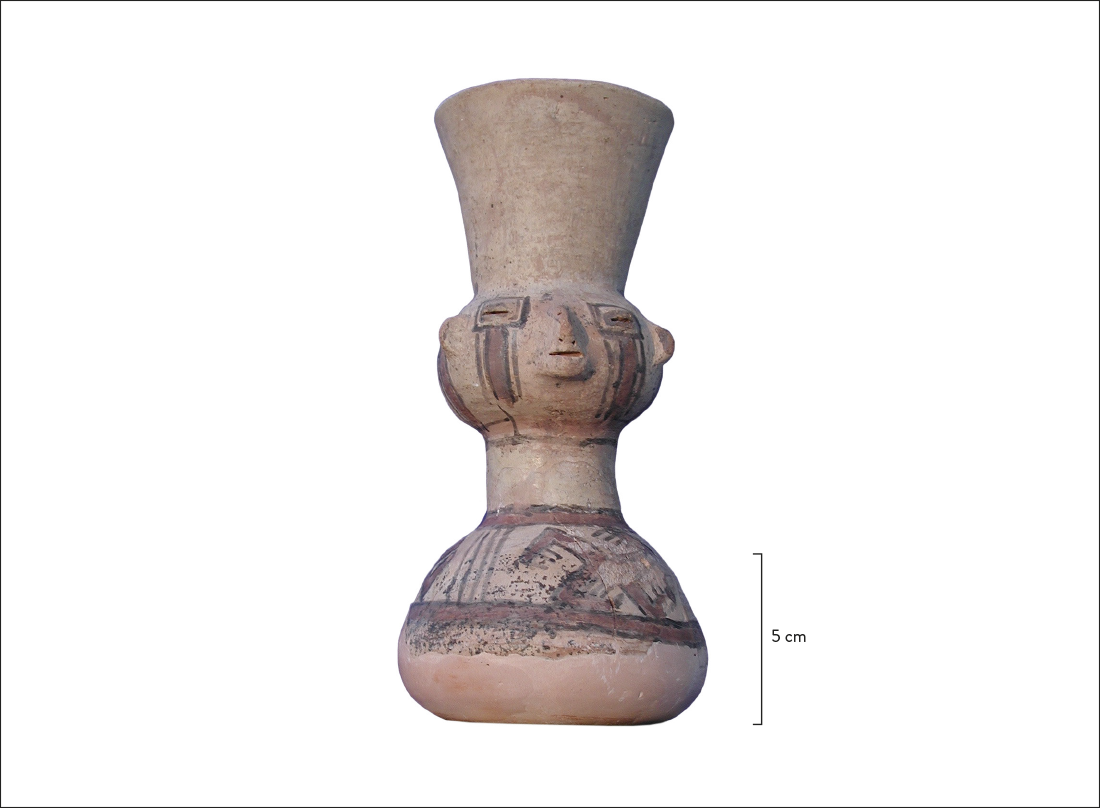
Figure 9. Huarpa Tricolor face-neck jar (one of three) that continues the Huarpa artisan ability to begin expressing realism into Stage 2 interpretations. Location: unknown. Fredy Lagos collection (photo by William H. Isbell). Figura 9. Cántaro cuello-efigie Huarpa Tricolor (uno de tres) que continúa la capacidad artesanal incipiente de los huarpa de expresar el realismo en las interpretaciones de la Etapa 2. Lugar: desconocido. Colección de Fredy Lagos (fotografía de William H. Isbell).

Figure 10. Huarpa Tricolor bowl with a Stage 2 creature created from endogenous shapes reinterpreted with the principle of integration of wavy bands for legs, comb shapes for feet, diamond shape for a head, and spirals for hair. Fredy Lagos collection (photo by William H. Isbell). Figura 10. Cuenco Huarpa Tricolor con una criatura de Etapa 2 creada a partir de la reinterpretación con el principio de integración de las formas endógenas de bandas onduladas para las piernas, formas de peines para los pies, una forma de diamante para la cabeza, y espirales para el cabello. Colección de Fredy Lagos (fotografía de William H. Isbell).

Figure 11. Huarpa Tricolor jar with a lobed body. Another Stage 2 creature depicts a reinterpretation similar to figure 10. This vessel also depicts the principle of rotation with a rosette of recurved rays. Fredy Lagos collection (photo by William H. Isbell). Figura 11. Cántaro Huarpa Tricolor con un cuerpo lobulado. Otra criatura de Etapa 2 representa una reinterpretación parecida a la figura 10. Este recipiente representa además el principio de rotación con una roseta de rayos recurvados. Colección de Fredy Lagos (fotografía de William H. Isbell).
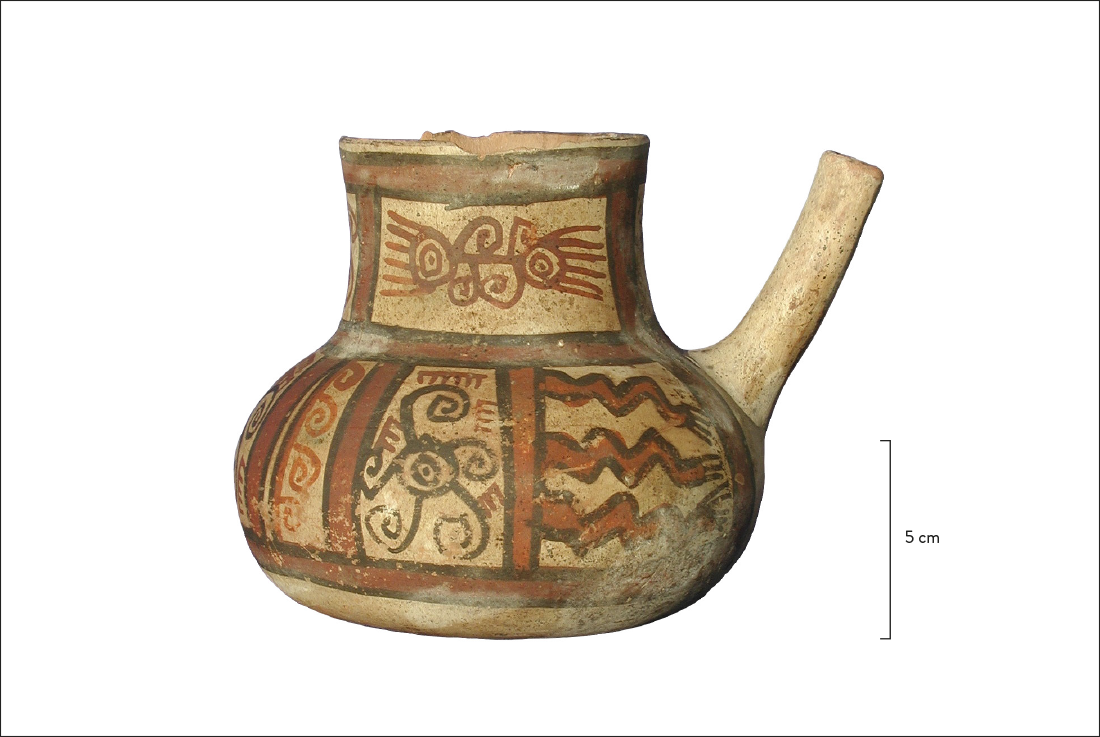
Figure 12. Huarpa Tricolor spouted bottle with a Stage 2 creature that may be double-headed with circled-dots for heads and lines for hair. The spirals may represent arms connected to a line as the body. Fredy Lagos collection (photo by William H. Isbell). Figura 12. Botella con pico Huarpa Tricolor con una criatura de Etapa 2 que podría tener dos cabezas con forma de círculos con punto en su interior y líneas como cabello. Los espirales quizás representan los brazos conectados a una línea representando el cuerpo. Colección de Fredy Lagos (fotografía de William H. Isbell).
Brown Cruz Pata style pottery coincides with the middle and late Huarpa phases. This style is also dominated with geometric designs in red, white, and black but painted on dark backgrounds. It partially supports the Lewis-Williams and Dowson model with its endogenous shapes of parallel zigzags, spirals, radials of spiral rays (Leoni 2004: figs. 11.6e and 11.21), concentric circles and squares (Leoni 2004: fig. 11.20), and a double-band spiral figure that Leoni (2004: 459, fig. 11.6a) described as a “serpent-like animal with a triangular head, and single and triple recurved ray appendages on its body”.(11)
Significantly, Brown Cruz Pata does not include chevrons, triangles, and L-spoked radials caused by non-intoxicants (table 1) though it does include examples of Stage 2 interpretations. Leoni (2004: fig. 11.20) described a possible zoomorphic image of a rectangular head with rectangular eyes associated with angular recurved rays in mirrored symmetry. Lumbreras (1974: fig. 147) illustrated a Brown Cruz Pata tall cup with handle painted with a similar zoomorph with square head, square eyes, and curved horn-like rays flanking a straight ray on top. Below the head hung three parallel wavy bands.
Brown Cruz Pata designs appear illuminated with extreme contrasts of white elements against a dark background. A rosette of recurved rays is delicately edged with white dots that give the impression of sparkling lights (fig. 13a). Painted on a dark background, white L-spoked radials appear to glow (fig. 13b). White star shaped radials give the effect of bursts of light (fig. 13c). These examples allude to intoxicant experiences of “flickering” (Maclay & Guttman 1941: 133), “crystals” (Lewin 1924, 1931; Beringer 1927), and mescaline’s “explosive” experiences (Siegel & Jarvik 1975). Brown Cruz Pata pottery also displays two shapes in this study that are the result of intoxicant experiences. These shapes do not originate with sais or Nasca but with Amazonia. The first is a vertical band of diamonds with filler dots (fig. 14) that occur with Huarpa Tricolor versions (fig. 11). The second is a complex crenellated pattern with filler circled-dot elements (fig. 15). Though it is not yet possible to know if Ayacucho’s neighbors immediately to the east during the eip originated such shapes, evidence for comparative origins for Brown Cruz Pata does exist in the Tukano art as studied by Gerardo Reichel-Dolmatoff (1971, 1978). His work influenced Lewis-Williams and Dowson (1993) to employ Tukano ecstatic art in their model. Between the Tukano and Ayacucho populations –a straight distance of 1600 km– are dozens of tribal groups. However, ethnohistorical and current Tukano traditions include linguistic exogamy that developed their extreme multilinguistic expertise and middleman trade status. Their knowledge and social position allowed them to leverage a diverse economy of trade (Sorensen 1967) that may have linked ancient trade networks. Tukano art includes many endogenous shapes such as grids, zigzags, concentric circles, and brilliant dots that can be created during intoxication. Their crenellated patterns (Reichel-Dolmatoff 1978: 29, figs. 33 and 50, plates iv and vi) and vertical bands of diamonds (Reichel-Dolmatoff 1978: plates iii and xlii) show significant similarities to the Brown Cruz Pata examples (figs. 14 and 15). Thus, Tukano art supports the possibility that Brown Cruz Pata style may have represented an Amazonian origin and influenced late Huarpa artisans.

Figure 13. Brown Cruz Pata designs illuminated with extreme contrasts of white against dark: a) bowl exterior with rosette of recurved rays delicately edged with white dots giving the impression of sparkling lights; b) bowl exterior with white L-spoked radials over a dark background, appearing to glow; c) tall-neck jar with white star shaped radials giving the effect of bursts of light. Location: Ñawinpukyo (Cabrera 1998) (photo by William H. Isbell). Figura 13. Los diseños de Cruz Pata Café iluminados con el contraste extremo entre blanco y color oscuro: a) el exterior de un cuenco con roseta de rayos recurvados bordeados delicadamente con puntos blancos, dando la impresión de luces brillantes; b) el exterior de un cuenco con radiales blancos con forma de “L” sobre un fondo oscuro que parece resplandecer; c) cántaro de cuello largo con radiales blancos con forma de estrella dando el efecto de estallidos de luz. Lugar: Ñawinpukyo (Cabrera 1998) (fotografía de William H. Isbell).
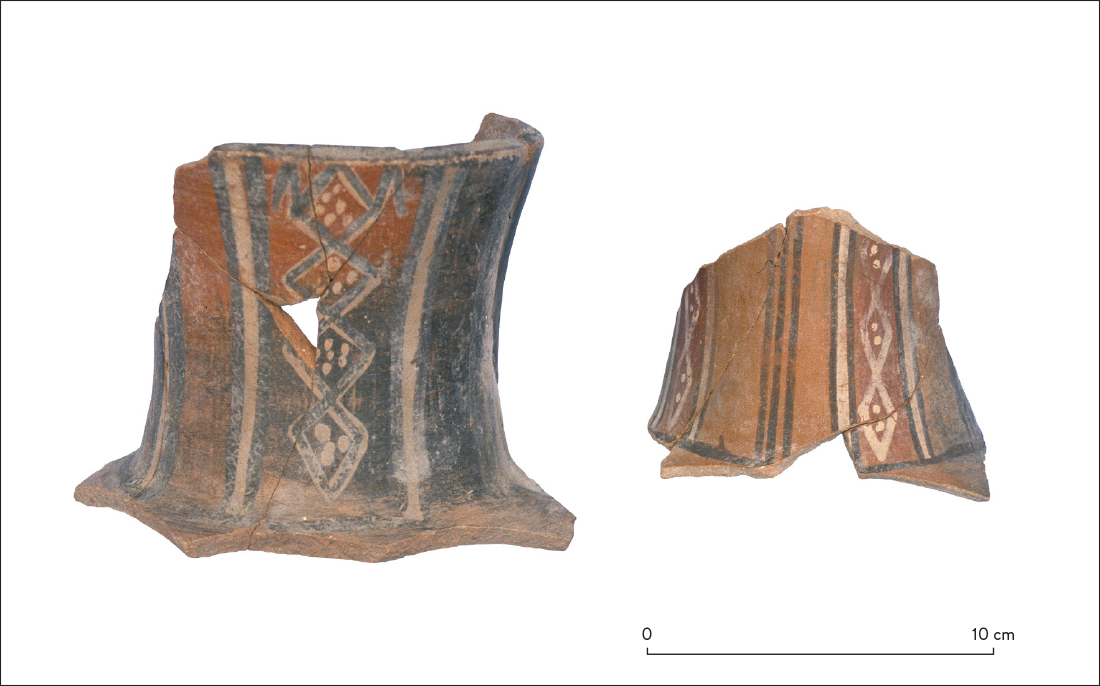
Figure 14. Brown Cruz Pata tall neck jars with vertical bands of diamond shapes with filler dots similar to Tukano endogenous shapes. Location: Ñawinpukyo (photo by Juan Leoni). Figura 14. Cántaros de cuello largo Cruz Pata Café con bandas verticales de diamantes con puntos de relleno parecidos a las formas endógenas de los tukano. Lugar: Ñawinpukyo (fotografía de Juan Leoni).
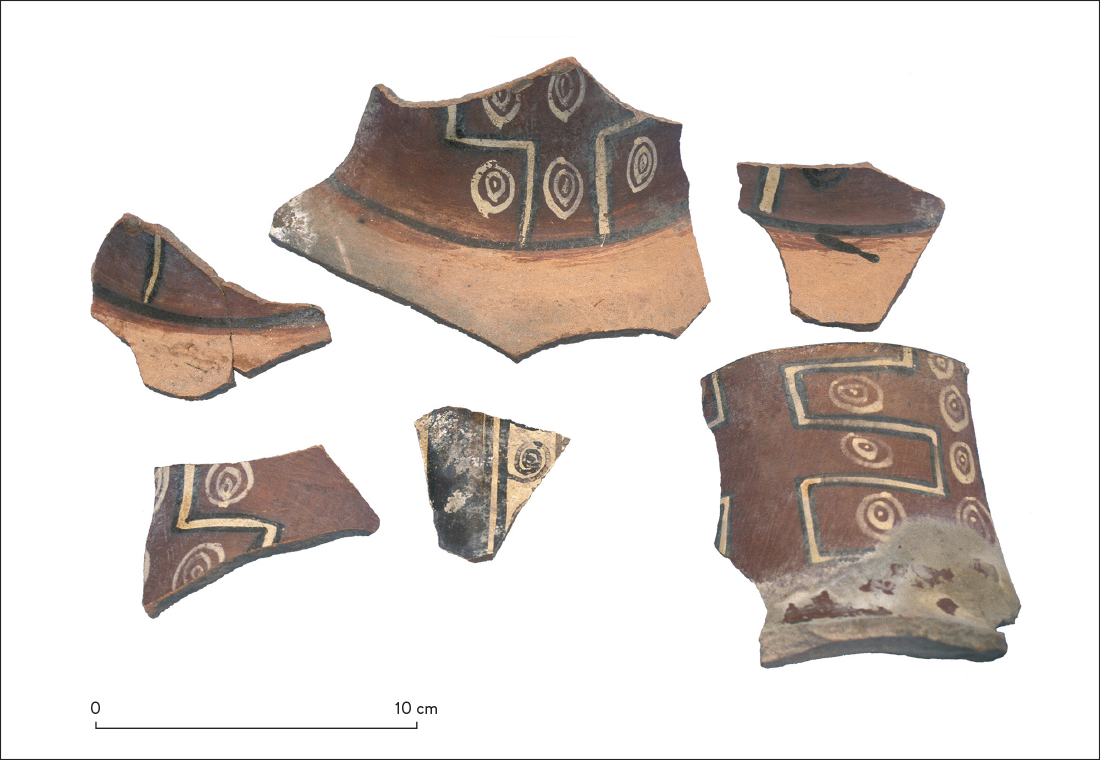
Figure 15. Brown Cruz Pata tall neck jar fragments with crenellated patterns of filler circled-dot elements similar to Tukano endogenous shapes. Middle sherd in lower row is Huarpa Black&Red-on-White style. Location: Ñawinpukyo (photo by Juan Leoni). Figura 15. Fragmentos de un cántaro de cuello largo Cruz Pata Café con patrones almenados de círculos con puntos en su interior como relleno parecidos a las formas endógenas de los tukano. El fragmento intermedio en la fila inferior es del estilo Huarpa Negro&Rojo sobre-Blanco. Lugar: Ñawinpukyo (fotografía de Juan Leoni).
DISCUSSION
This investigation of the Huarpa culture is not sup-ported as well with ethnographic analogy as what the San culture provides to Lewis-Williams. Rather, evidence that relates to mh Andean archaeology is a more pertinent substitute. Middle Horizon intoxication is best documented with snuffing kits of wood or bone tubes and wood or stone palm-sized trays found with mummy burials in the San Pedro de Atacama region of northern Chile (Le Paige 1965; Llagostera 2006; Torres & Repke 2006; Torres 2018), dry coastal sites such as Puerto Nuevo de Paracas in the Nasca area (Wassén 1972: 72, fig. 14) and Castillo de Huarmey on the north coast (Prümers 2001), and dry caves (Wassén 1972) and open sites around Lake Titicaca (Posnansky 1957; Bermann 1994; Couture 2003; Janusek 2004; de la Vega et al. 2005). Most wood artifacts are nonextant in the rainy Wari heartland, whereas ceramic lyre-shaped cups (Lumbreras 1960: 158; Menzel 1964: 16) and goblet-shaped keros indicate feasting with a regional intoxicant, chicha beer. Large urns excavated at Conchopata depict five abstrusely painted plants growing out of round anthropomorphic heads (Ochatoma & Cabrera 2002: fig. 8.8e; Mancilla 2012: 167). One has a serrated trunk ending at a flat top (similar looking to Schlumbergera). The second has a narrow white trunk with alternating white stem bands ending in black, diamond-shaped tips; perhaps depicting Psilocybin mushrooms that grow into tight clumps that appear multi-stemmed. The third resembles oak leaves with pointed lobes. The fourth is multi-stemmed like san Pedro cactus, Echinopsis pachanoi, a mescaline source. The fifth has white, circled-dot flowers, legume-shaped pods, and lanceolate leaves. It was identified as Anadenanthera colubrina (Knobloch 2000: 389-390) and is depicted on numerous sais artifacts including the faces, coronas, staffs, and clothing of supernatural icons. Beyond reasonable doubt, this evidence supports the practice of intoxication in Wari rituals. Did Huarpa ancestors bequeath such ritual agency?
Huarpa occupations were distributed throughout the valley to encompass three main eco-environments for food production and herding (Pérez 2016). At Huari, Huarpa settled along the northern and western edges of the mesa (Bennett 1953: 29, table 2; Knobloch 1976, 1983; Ochatoma et al. 2015), at the eastern gateway to the mesa at Churukana (Cavero & Huamani 2015), and the southwest corner at Vista Alegre (Meddens 1978). Perhaps the mesa’s large, core area was cultivated or corralled for camelids. José Ochatoma, Carlos Mancilla, and Martha Cabrera’s (2015) excavations discovered beautifully plastered Huarpa enclosures of rectangular columns, floors, and canal systems underlying Wari occupation.
Huarpa ceramic production and decorative execution demonstrate a highly skilled artisanship (Lumbreras 1974; Knobloch 1976; Leoni 2004). Vessels include large and small bowls and jars, spouted jars, bottles, spoons, tall cups with handles, figurines, and whistles. Decoration includes pigments, appliqué, and modeling. Black and black-outlined-red geometric designs were painted on white-pigmented or unpigmented, buff-orange background. Techniques that continued into the mh were face-neck jars, multi-lobed-neck bottles, spoons, and a prerequisite design layout of rectangular panels before adding motifs. White Cruz Pata pottery confirms contact with Nasca populations who produced an exquisite polychrome pottery tradition (ad 100-650) (Proulx 2006). Borrowed motifs include recurved rays on wavy bands and symmetrical rosettes of tripart rays (Leoni 2004: fig. 10.2B). Brown Cruz Pata pottery indicates contact with and possible assimilation to Amazonian cultures. Thus, the distribution and stylization of Huarpa pottery records a society actively networking among valley-wide communities and accepting foreign diversity. Therefore, Huarpa identity communicated a stable autonomy and ability to participate in foreign diplomacy.
Another Huarpa community settled at Ñawinpukyo, another mesa site (Lumbreras 1974). Juan Leoni’s (2004, 2005, 2006) excavations exposed what he considers was a temple with an 82 × 45 m walled plaza with a 12-13 m round temple within which is an interior 6-7 m circular wall around a 2 m central circular feature. The entrance is 30 cm wide and aligned towards the area’s highest mountain, Rasuwillka (Leoni 2005: fig. 4).
CONCLUSION
The general remoteness of Huarpa society isolated their culture until their exploration or exploitation focused attention on the southcoast Nasca culture. The extent of this contact did not involve trade of pottery but more of imagery as early Huarpa’s black-on-white designs occur on Nasca pottery. Designs could be transferred on textiles and certain Nasca 6 effigy bottles depict agents wearing black-on-white checkerboard tunics (Proulx 2006: 176, fig. 5263).(12) Perhaps the Nasca had an interest in the Huarpa to sustain camelid herds and as middlemen to obtain Amazonian resources such as parrot feathers and monkeys. In middle Huarpa society, White Cruz Pata resulted from continuing contacts with the coast, though filtered through conservative practices in local pottery techniques. On the other hand, Brown Cruz Pata stemmed from contacts with Amazonian societies as Huarpa leaders leveraged their privileged position as middlemen. This evident positioning between the coast and the Amazon could have established a Huarpa reputation for negotiation and partnership that directionalized the advancement of Wari-like interests. The Late Huarpa phase essentially caps the culture’s sustainability during centuries of increasing interconnectedness that culminated in the displacement of ancestral traditions with foreign-based innovations and attracted more ambitious generations. The Lewis-Williams and Dowson model intrinsically mirrors this chronology of increased intoxicant experiences among the Huarpa. Thus, early Huarpa shapes show little or no evidence of stimuli to create hallucinations, whereas late Huarpa endogenous shapes were being manipulated into indecipherable creature forms. Such manipulations are a key result of asc. However, the Huarpa shapes of L-spoked radials from optical stimulation and chevrons from migraines lend support to a society without a tradition of intoxication. These inconsistencies could lead to a dead end in deciding whether the Huarpa practiced ecstatic shamanism. However, Lewis-Williams and Dowson (1990: 407-408) state that, “As much as any of our critics we resist identifying practically any geometric motif by itself as entoptic [endogenous] in origin and therefore indicative of shamanism […]. Certainly, we should like to find other archaeological evidence for shamanism”. Thus, their model culminates when tested with other evidence that contextualizes ritual behavior. Such evidence exists in the construction of a Huarpa temple atop Ñawinpukyo. Its only entrance frames the snow-capped Rasuwillka peak, the highest peak visible to Ayacuchanos that is “the home of a hatun wamani or major mountain deity in contemporary Andean cosmology” (Leoni 2006: 288). As Leoni (2004) cogently points out, the sacred nature of this ancestral sector was so potent that the Wari never usurped the site with burials and constructions as was done with Huarpa occupations at Huari (Ochatoma et al. 2015). Moreover, the temple’s three circular walls constrained participants to follow a spiral path into the center thereby walking maze-like in an endogenous shape. This architectural planning reasonably implies that the sector was related to cult activities including sacrificial offerings: animal bones with butcher marks were found in piles as though buried in bags into the floors of the structure. Such cult activity most likely depended on respected and divine authority, so, perhaps, shamans.
Further evidence for possible shamanism is the association of Huarpa and Brown Cruz Pata pottery that document Amazonian partnerships. Amazon cultures are undeniably involved with ecstatic rituals that may involve shamans only or more communal access. The Tukano art is known to be the direct result of ecstatic experiences created with yagé intoxication –an ayahuasca recipe. Thus, the Amazonian Brown Cruz Pata style may indicate a foreign introduction of a proto-ayahuasca recipe into Huarpa rituals. Along with the Tukano connections, Paola González (2013: 33) describes other observable shamanistic art among the Shipibo-Conibo (Gehbart-Sayer 1985) and Caduveo (Lévi-Strauss 1992 [1955]) as well as the Chilean Diaguita art that, curiously, she describes as having an “inquietante similitud” or disturbing similarity. However disturbing, similarities between distant art traditions suggest ancient contacts and antecedent population dynamics. Besides the ubiquitous black-and-red-on-white pigments, only the Diaguita designs of alternating pyramidal-shaped triangles (González 2013: 150) have similarities to Huarpa examples (figs. 2p and 4) and are too few to determine reasonable connections, though similarities between interlocking fret patterns (González 2013: 96-99, 126-139) and Wari’s mh2 Viñaque style may foster future investigations.
And finally, a most noteworthy find in Leoni’s excavations is a Brown Cruz Pata face-neck jar that depicts an individual with closed eyes and a tunic that displayed concentric circles and vertical bands of diamonds (fig. 16). Leoni (2004: 398) pointed out that in contrast to Huarpa style, “Cruz Pata faces are represented with eyes closed or semi-closed, either in the form of a very thin incised slit or as a simple painted line”. Rather than pass over this expression as representing sleep, I argue that it is the typical expression of a shaman in trance. As a record to the introduction of shamanistic agency among the Huarpa, we are fortunate to have this artifact “witness” from the past.
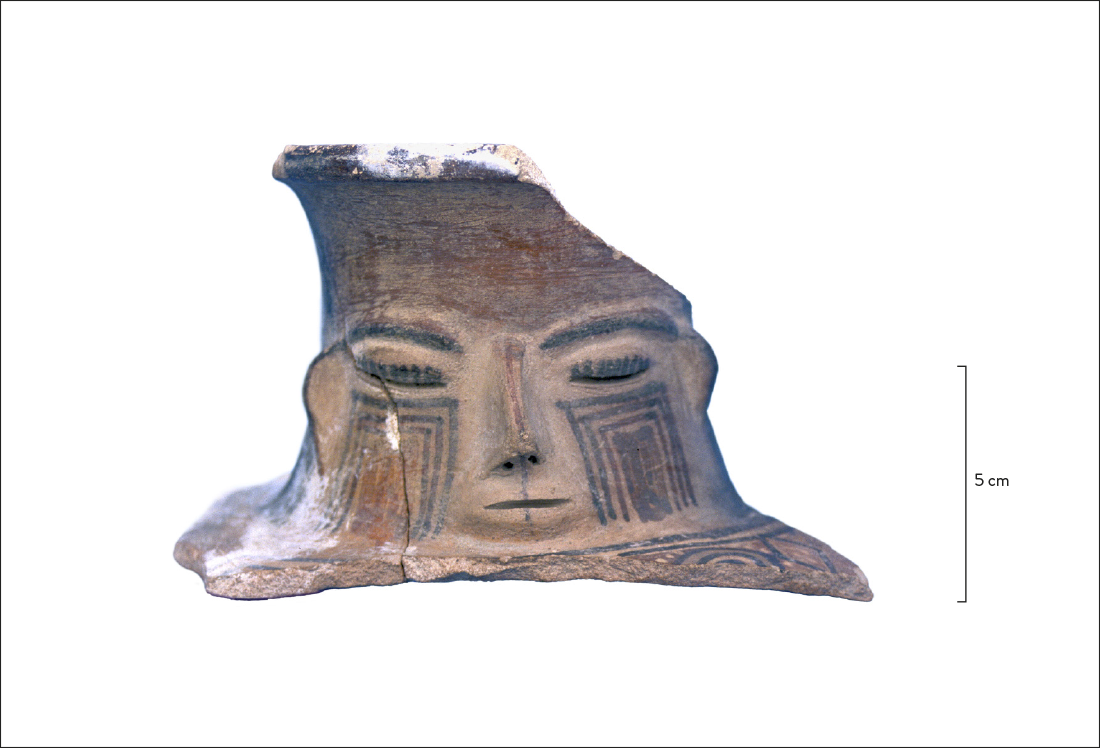
Figure 15. Brown Cruz Pata tall neck jar fragments with crenellated patterns of filler circled-dot elements similar to Tukano endogenous shapes. Middle sherd in lower row is Huarpa Black&Red-on-White style. Location: Ñawinpukyo (photo by Juan Leoni). Figura 15. Fragmentos de un cántaro de cuello largo Cruz Pata Café con patrones almenados de círculos con puntos en su interior como relleno parecidos a las formas endógenas de los tukano. El fragmento intermedio en la fila inferior es del estilo Huarpa Negro&Rojo sobre-Blanco. Lugar: Ñawinpukyo (fotografía de Juan Leoni).
acknowledgements I am deeply grateful for the support from the following friends/colleagues: collecting the 1974 pottery –William H. Isbell and Katharina Schreiber; providing workspace at the Museo Nacional de Arqueología, Antropología e Historia del Perú (mnaahp) –Luis Lumbreras; excavating the 1977 pottery –Christina, Michael Brewster-Wray and Perry Gnivecki; translating the abstract –Leila Assolin; creating the map –Marc Marino; and generously sharing photographs from their fieldwork in 1998 –Martha Cabrera (courtesy of William Isbell), and in 2001 –Juan Leoni. I truly appreciate the references from two reviewers in adding more lines to the Wylie-like chain of intoxicant agency.
Anders, M. 1986. Dual Organization and Calendars Inferred from the Planned Site of Azangaro Wari Administrative Strategies. ph.d. dissertation, Department of Anthropology, Cornell University, Ithaca.
Arnold, D. & E. Espejo 2013. El textil tridimensional: la naturaleza del tejido como objeto y como sujeto. La Paz: Fundación Interamericana-Fundación Xavier Albó-Instituto de Lengua y Cultura Aymara.
Arnold, D. & E. Espejo 2015. The Andean Science of Weaving. Structures and Techniques of Warp-faced Weaves. London: Thames & Hudson.
Bednarik, R. 1984. On the Nature of Psychograms. Artefact 8: 27-32.
Bennett, W. 1953. Excavations at Wari, Ayacucho, Peru. New Haven: Yale University Press.




